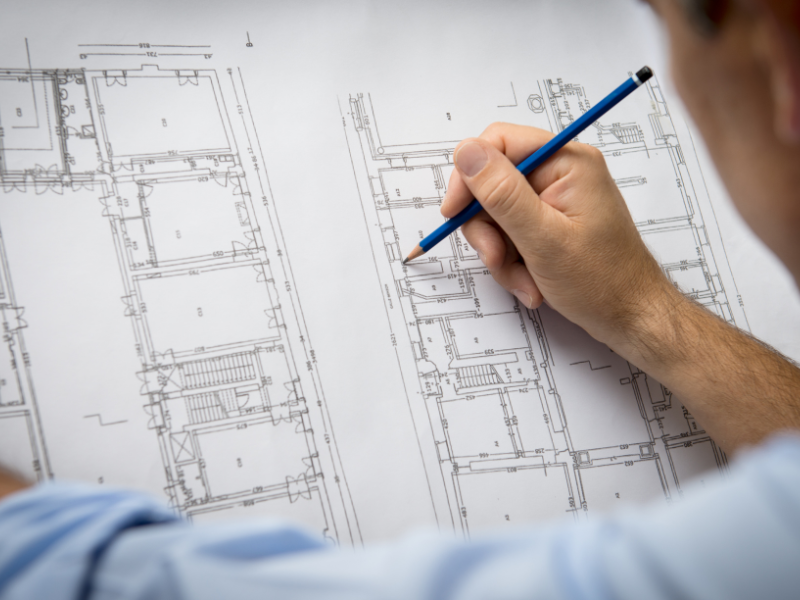Architect Marketing Strategies to Reach Premium Clients
Wiki Article
Recognizing the Diverse Occupation Paths Available for Aspiring Architect
As an aspiring Architect, you have a globe of job paths waiting for you. Whether you're drawn to conventional style or the subtleties of sustainable layout, there's a specific niche that aligns with your rate of interests.Conventional Architecture: Designing Buildings and Frameworks
Traditional style concentrates on designing buildings and frameworks that mix capability with visual appeal. As you explore this area, you'll appreciate the intricate equilibrium between kind and function. You'll discover to draw motivation from historical designs, integrating elements like balance, materials, and workmanship. Your designs can reflect cultural heritage, showcasing neighborhood customs while meeting modern-day needs.You'll create skills in composing, model-making, and website evaluation, enabling you to picture and interact your ideas efficiently. Engaging with clients, you'll need to understand their vision and convert it into viable layouts.
Additionally, constructing codes and sustainability techniques are crucial in your job, ensuring your structures are eco pleasant and secure. As you expand in your career, you'll discover opportunities in property, business, or perhaps reconstruction projects, each offering special challenges. Welcoming traditional design leads the way for a meeting job that admires the past while shaping the future.
Urban Preparation: Shaping Neighborhoods and Public Spaces
As a hopeful Architect, you can play a necessary duty as an urban coordinator, transforming exactly how neighborhoods function and interact. By using community interaction methods, you'll ensure that residents have a voice in forming their atmosphere. Plus, integrating sustainable layout principles will certainly assist create areas that not just satisfy today's requirements however likewise protect the future.Role of Urban Planners
While many may assume of architects as the single dreamers behind structures, city planners play an important function in forming the more comprehensive landscape of neighborhoods and public rooms. By teaming up with different stakeholders, you'll assist develop parks, transportation systems, and property areas that promote social communication and access. Your proficiency in spatial layout and community characteristics permits you to envision future development while protecting cultural heritage.Community Engagement Techniques
Effective neighborhood engagement approaches are important for urban organizers to ensure that the voices of citizens are listened to and valued in the planning process. To promote purposeful dialogue, you need to focus on open online forums and workshops where community members can share their ideas and concerns. Use studies and social networks to get to a wider target market, guaranteeing varied viewpoints are included. Collaborating with local companies can boost trust fund and help with much deeper links. It is necessary to give clear info regarding proposed jobs and decision-making processes, allowing residents to feel educated and equipped. By actively paying attention and including comments, you'll develop spaces that mirror the community's needs, ultimately leading to even more successful and sustainable urban environments. Embrace openness and continuous discussion for lasting influence.Sustainable Style Concepts
When making urban rooms, integrating sustainable layout concepts is critical for developing settings that flourish both ecologically and socially. You should begin by concentrating on energy performance, utilizing products that minimize waste and advertise recycling. Think about incorporating green areas, like yards and parks, to boost biodiversity and improve air quality. Promoting walkability and public transport can reduce dependence on cars and trucks, cultivating a much healthier area.Designing with water preservation in mind is likewise crucial-- consider rain gardens and permeable surface areas to take care of stormwater. Entailing neighborhood members during the preparation procedure warranties that the spaces you create satisfy their demands and encourage social interaction. By welcoming these concepts, you'll add to lively, sustainable metropolitan landscapes that benefit everyone.

Landscape Architecture: Creating Lasting Outside Atmospheres
As you discover landscape style, you'll uncover crucial design principles that create beautiful and useful exterior spaces. Lasting practices play a vital function in ensuring these environments grow while decreasing environmental effect. And also, you'll discover a variety of career possibilities that permit you to make a genuine difference in just how people communicate with nature.Design Principles in Landscape
Comprehending design concepts in landscape style is necessary for creating lasting outside settings that balance with nature. You'll need to ponder elements like percentage, range, and balance to assure your styles really feel cohesive and inviting. Additionally, pay focus to seasonal modifications, making with products that match the surroundings year-round.Lasting Practices Review
Lasting practices in landscape style not just concentrate on looks yet also focus on environmental health and wellness and source preservation. You can develop areas that promote soil health and wellness, such as making use of natural materials and exercising permaculture concepts. Ultimately, these methods assure your layouts profit both individuals and the environment for years to come.Career Opportunities Expedition
With a strong structure in lasting methods, landscape architecture supplies a range of career courses that permit you to make a significant impact on the setting. Urban coordinators frequently work together with landscape architects to develop eco-friendly spaces in metropolitan settings, improving city livability. If you're passionate concerning education, take into consideration ending up being a landscape style teacher, motivating future generations.Sustainable Layout: Focusing on Eco-Friendly Practices
As you explore your profession in style, embracing green methods can establish you apart in an affordable field. Lasting design concentrates on developing buildings that decrease environmental effect while boosting resident well-being. By incorporating eco-friendly materials, energy-efficient systems, and lasting building techniques, you'll add to a greener future.Beginning by acquiring understanding of environment-friendly accreditations like LEED or BREEAM, which can bolster your credentials. Think about just how natural light, ventilation, and thermal effectiveness can optimize style. Team up with designers and environmental consultants to introduce remedies that minimize waste and conserve resources.
Don't neglect the significance of neighborhood participation-- engaging local stakeholders can influence styles that integrate with the setting. his comment is here As customers significantly prioritize sustainability, your experience in eco-friendly practices will not only attract projects however likewise satisfy your enthusiasm for accountable design. Embrace this crucial element of the profession, and view your profession thrive.
Historic Preservation: Protecting and Restoring Social Heritage
While you start on your building trip, take into consideration the crucial duty of historical preservation in maintaining our cultural heritage. This field concentrates on the defense and repair of considerable buildings, sites, and frameworks that inform the stories of our past. By engaging in historical conservation, you'll aid secure the architectural legacy that forms neighborhood identity.As a historic conservation Architect, you'll assess historic significance and analyze the condition of frameworks. You'll function very closely with historians and preservationists to ensure genuine reconstruction methods are used. This profession course allows you to blend creativity with research study, allowing you to develop solutions that appreciate initial products and craftsmanship.
Your job not just adds to sustainability by recycling existing structures but likewise cultivates a sense of satisfaction within areas. Accepting this path will certainly aid you become a guardian of background, maintaining the stories and looks that enrich our lives.
Interior Style: Enhancing Indoor Spaces
Historical preservation and interior design both share a dedication webpage to enhancing the built atmosphere, yet they focus on different elements. While historical preservation emphasizes preserving a framework's cultural and historical value, indoor style nos in on maximizing indoor spaces for performance and appearances.As an aspiring Architect, you'll find that interior architecture enables you to blend imagination with technical skills. You'll make rooms that not only look good but also promote convenience and efficiency. This area involves understanding how light, color, and materials communicate within a space, impacting mood and functionality.
You'll deal with different jobs, from property homes to industrial offices, making certain that each setting fulfills the demands of its passengers. By focusing on individual experience, you can change insides right into functional and inspiring spaces, making a significant influence on how people engage with their surroundings. Embrace the opportunity to boost interior atmospheres and shape the way individuals live and function.
Industrial Design: Combining Capability With Aesthetics
Industrial layout plays a crucial duty in producing products that flawlessly mix looks with performance, ensuring that what you make use of everyday is not only aesthetically enticing however also sensible. As a hopeful Architect, you could involve yourself in this area, focusing on designing whatever from furniture to customer electronics. Your job includes recognizing individual demands, materials, and making processes, permitting you to create ingenious solutions that boost everyday experiences.In commercial design, you'll often work together with suppliers, online marketers, and designers, making certain that your designs are not only gorgeous however also practical. You'll find out to balance kind and function, prioritizing functionality without giving up style. By developing your abilities in sketching, 3D modeling, and prototyping, you'll be well-appointed to bring your concepts to life. This career path provides a dynamic setting where creativity satisfies functionality, making it a fulfilling choice for architects thinking about forming the items of tomorrow.
Regularly Asked Concerns
What Educational Accreditations Do I Required to Become an Architect?
To come to be a designer, you'll require a specialist degree in architecture, commonly a Bachelor's or Master's. Furthermore, you'll have to finish an internship and pass the Architect Enrollment Evaluation to exercise lawfully.Are There Accreditation Requirements for Various Building Job Paths?
Yes, there're accreditation requirements for numerous architectural paths. Architect. You'll require to pass examinations, complete teaching fellowships, and sometimes seek specialized training, depending on your chosen emphasis, like landscape architecture, metropolitan design, or historic conservationWhat Software Skills Are Vital for Engineers Today?

Just How Can I Gain Practical Experience While Studying Style?
You can get practical experience by interning at building firms, getting involved in design competitors, volunteering for area projects, or teaming up with classmates on real-world jobs. These chances boost your skills and construct useful connections in the market.What Job Opportunities Exist Outside Typical Design Firms?
You can discover different job chances outside typical architecture companies, like city planning, indoor layout, landscape architecture, building and construction management, genuine estate growth, or perhaps roles in sustainability consulting. Each deals unique difficulties and incentives.Whether you're attracted to traditional design or the subtleties of sustainable layout, there's a niche that lines up with your passions.When making visite site urban spaces, including lasting design principles is important for developing settings that thrive both ecologically and socially.As you check out landscape style, you'll uncover essential design principles that develop useful and lovely exterior areas.Understanding design principles in landscape architecture is important for developing lasting outside settings that harmonize with nature.In commercial design, you'll usually team up with engineers, makers, and online marketers, guaranteeing that your layouts are not just lovely however additionally practical.
Report this wiki page